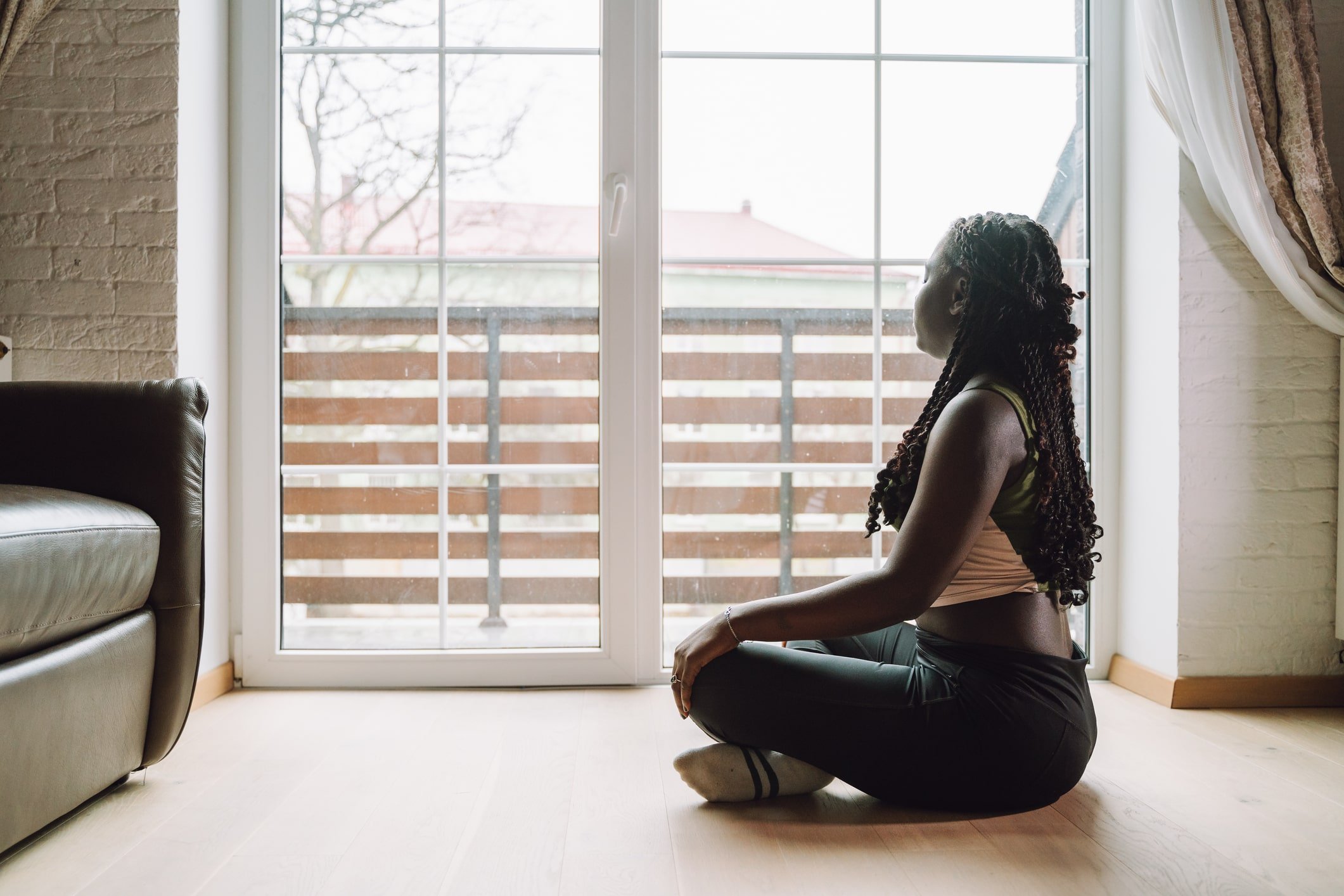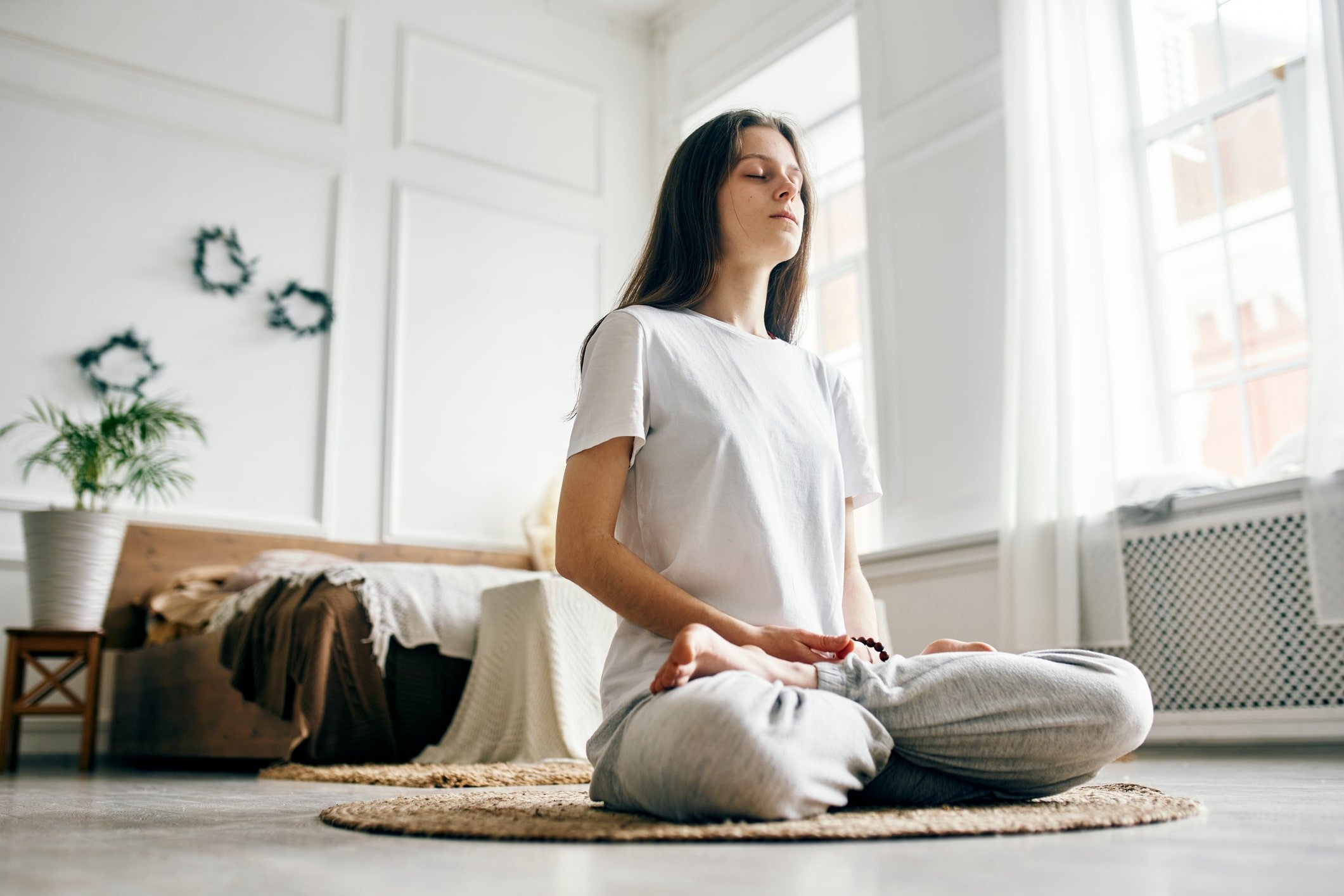How to sit for meditation: 5 seated positions to try

Clinically reviewed by Dr. Chris Mosunic, PhD, RD, CDCES, MBA
Discover seated meditation positions for your practice. Whether you prefer sitting in a chair or sitting in lotus, we help you find the best posture for you.
What to know:
💙 Your meditation posture should feel both stable and comfortable—aligned spine, relaxed body—so you can stay present without pain or distraction.
💙 Chair sitting, easy cross-legged, lotus, and kneeling are all effective seated meditation positions. Props like cushions or blankets can help with comfort and alignment.
💙 If seated postures aren’t right for your body, lying down, walking, or standing meditations still have the same benefits.
Just as everyone’s journey to mindfulness is unique, the best meditation position will be personal to you. Whether you're just beginning your mindfulness journey or looking to deepen your practice, finding the right meditation sitting position can make a world of difference in your meditation practice. A supportive and stable meditation posture helps you stay present, breathe with ease, and maintain focus — so you can actually enjoy your meditation practice, not just endure it.
There are a variety of positions to explore that could help you achieve deeper focus and inner tranquility, but if that sounds intimidating don’t worry, we’ve got you.
Let’s explore five foundational seated meditation poses you can try today. Whether you prefer a cushion on the floor, a chair, or a traditional yoga meditation pose, we’ll help you discover what works best for your body.
5 seated meditation poses to explore
The foundation of a meaningful meditation session often starts with your posture and should always be comfortable. A good seated position can give stability and help align your spine while opening up your chest for easier breathing. The key is to explore different positions until you find one that allows you to meditate for longer periods without physical discomfort.
Regardless of the position you sit in for meditation, you want to make sure your spine is aligned. This means making sure your head is directly over your heart and making sure that your center is positioned over your hips. If you are seated on the floor you can sit on a rolled up blanket or cushion to help support this alignment. This position will offer you support and comfort if you’ll be seated for an extended period of time.
💙 If you’re new to meditation and unsure where to start, try Meditation for Beginners.
For a visual aid, check out this video where meditation expert, Tamara Levitt talks about the best ways to sit for meditation.
1. Sitting in a chair
Sitting in a chair might be the easiest position to sit in for meditation. It provides back support while also providing comfort. While you might think you need to sit in lotus position to garner the full benefits of meditation, that's simply not true. To practice meditation while seated in a chair sit with a straight back with your legs uncrossed. You can use pillows to support the lower back if needed and you can place your feet on a rolled up blanket or cushion if they don’t reach the floor comfortably.
Remember, the best seated position for meditation is the position you can sit in comfortably so you’re focusing on the practice, not on an achy hip or scrunched up knee.
2. Easy cross-legged pose (sukhasana)
This pose is a classic when it comes to meditation, and for good reason. It’ll probably remind you of the way you used to sit in class as a kid with your legs crossed in front of you and your feet tracking beneath the opposite knee.
This pose is accessible and comfortable for most people, although if you notice your knees raised, you can add some pillows, folded blankets, or yoga blocks beneath your knees for added support. You can also add a cushion below your seat to help your posture.
3. Sitting on the floor with your legs and ankles folded in front of you
Similar to the cross-legged position, this variation (also known as burmese position) has you sitting with both legs folded in front of you, one in front of the other so your ankles are stacked. If you’re struggling to keep a straight spine, place a cushion under your seat to elevate your hips and ease pressure on your legs.
4. Sitting in lotus position (advanced)
Lotus is a more advanced posture that is accessible for those that have flexibility in the hips, and may not be comfortable for everyone. There are a number of variations to this pose including:
Quarter lotus where you sit with one foot placed on the opposite thigh while the other foot remains below its opposite thigh.
Half lotus where only one foot is placed on the opposite thigh.
Full lotus where both feet are placed on the opposite thighs. This pose requires advanced flexibility so if you’re new to sitting for meditation proceed with caution.
The key is to experiment and find what’s comfortable for you. If you’re attempting to pretzel yourself into a position that causes any pain, please come out of the pose as it may lead to physical injury and is unlikely to help you drop into your meditation practice.
If you’ve had any sort of injury to the lower body you may want to consult your healthcare provider to determine the best position for you to sit in for meditation.
5. Kneeling position
To practice a seated kneeling position for meditation, sit on your heels while keeping your spine straight. This position offers an alternative kind of stability and can relieve tension in the legs, but if sitting on your heels causes discomfort, try placing a cushion between your legs and heels to provide relief. If your knees feel uncomfortable in this position try another where they feel more comfortable. If your knees are elevated, try placing cushions under them for support.
💙 Sitting for too long could result in some discomfort, but we got you. Check out the Daily Move with Mel Mah to increase mindfulness and flexibility all in one fell swoop.
Other meditation positions to try
Not finding what you’re looking for in the list above? That’s okay! There are numerous other meditation positions you can try such as meditating while lying down, kneeling, walking or standing.
A good meditation position can pave the way for a successful meditation habit so if a seated posture doesn’t work for you, try something else. There is no wrong way to meditate as long as you’re tuned into your body and the breath and feel comfortable and safe.
Lying down meditation
Meditating while lying down can be great if you want to relax your entire body while meditating or if seated positions are painful due to physical limitations or injury. Lying down while meditating is also ideal if you’re practicing a sleep meditation to help you fall asleep because if you fall asleep, you’re already in the perfect position.
Lie flat on your back on a comfortable surface, arms by your sides with palms facing upwards, and legs naturally apart. Close your eyes, and begin to focus on your breath, allowing your body to relax completely into the floor. This position promotes total relaxation.
Standing meditation
Standing meditation can help cultivate groundedness and awareness.To practice standing meditation stand comfortably with your feet hip-width apart and knees slightly bent. Rest your hands by your sides or place them together in front of your chest. Focus on your breath, feel the connection to the earth, and maintain a relaxed but upright posture.
Walking meditation
This form of meditation is excellent for those who find stillness challenging and prefer movement. Choose a quiet and flat path for walking meditation. Start at a slow pace, being mindful of the sensation of your feet lifting off, moving through the air, and making contact with the ground. Coordinate your breathing with your steps, for instance, inhaling for three steps and exhaling for three steps.
💙 Walking meditation is a wonderful way to combine movement, time in nature and mindfulness.
Meditation positions FAQs
What is the best meditation posture for beginners?
The best meditation posture is one that allows you to sit comfortably while keeping your spine aligned. For beginners, sitting in a chair or in an easy cross-legged meditative pose on a cushion is ideal. The goal is to maintain an upright, relaxed position where you can breathe fully and stay focused without strain.
Can I meditate lying down or standing?
Yes. Meditating while lying down is an effective way to practice, especially if sitting causes you discomfort or pain. Lying down can support deep relaxation, while standing meditation encourages grounded awareness and focus. Choose the position that supports your intention and feels right for your body.
Do I need to sit in lotus pose to meditate effectively?
No. Full lotus is an advanced meditating position that isn’t required for a successful practice. You can experience the full benefits of meditation in any stable and comfortable seated position—whether it’s sukhasana (easy pose), burmese position, or sitting in a chair.
How do I know if my meditation posture is correct?
A good meditation posture feels both relaxed and alert. Your head should stack over your shoulders, shoulders over hips, with your hands resting gently. If your back is rounding or you're shifting frequently, consider adjusting your cushion or trying a different pose like kneeling or a supported chair position.
Is there a difference between yoga meditation poses and regular seated meditation?
Yes and no. Many seated meditation postures used in yoga—like lotus or hero pose—are also used in general meditation. What matters most is your alignment, comfort, and ability to stay present. Whether it’s yoga-based or not, the best meditation sitting posture is the one that works for you.
How long should I sit in one meditation pose?
Start with 5–10 minutes and increase over time. If you're new to meditation, try different meditation sitting positions to see which one allows you to sit longer without discomfort. Use props like cushions, blocks, or blankets to support your body and maintain a relaxed yet focused posture.
How do I know if I'm actually meditating?
Generally speaking, if you’re consciously focusing your attention—whether it's on your breath, an affirmation, or even just the present moment—you are meditating. Over time, you'll likely notice an increased ability to focus, and greater feelings of calm and clarity. These are indicators that you’re meditating effectively.
Is it OK to doze off during meditation?
Falling asleep during meditation is a common experience, especially for beginners or for those practicing relaxation or lying down techniques. While the purpose of most meditation sessions is to remain awake and aware, dozing off isn't necessarily a failure. It may indicate that you're in deep relaxation or perhaps that you need more sleep. If you find you fall asleep frequently during meditation try a more upright position or practice at times when you're less tired.
Calm your mind. Change your life.
Mental health is hard. Getting support doesn't have to be. The Calm app puts the tools to feel better in your back pocket, with personalized content to manage stress and anxiety, get better sleep, and feel more present in your life.









